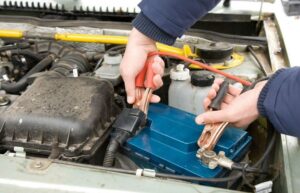An automobile battery , or SLI battery (for ” starting-lighting-ignition “), is a storage battery supplying electrical energy under 12 volts to a thermal motor vehicle , or a higher voltage in electric vehicles, hybrids or micro-hybrids.
The first automobiles did not have a battery. Electrical equipment was almost non-existent, the vehicle was started with a crank , and the spark ignition was generated by a magneto ignition .
In 1918, the American automobile manufacturer Hudson Motor Car Company was the first to use batteries standardized by the Battery Council International (en) 1 . Batteries began to be used massively from the 1920s when cars were fitted with electric starters 2 .
The first start-recharge system is designed for a voltage of 6 volts with a positive ground . This involved connecting the positive terminal on the vehicle chassis 3 . The design has since been changed to negative ground, this change was made between the 1930s and 1960s at the pace of automobile manufacturers.
Automobiles were equipped with 6 V systems until the mid-1950s. The change from 6 to 12 V occurred as vehicles became larger: the compression ratio of engines was higher and required more energy to start , this makes it possible, among other things, to halve the section of the electrical cables for the same distributed electrical power 4 . However, some smaller automobiles continued to be fitted with 6 V batteries for some time, notably the Beetle until the mid-1960s and the Citroën 2 CV until 1970.
The development and distribution of hybrid and electric vehicles during the late 20th and early 21st centuries brought changes to the types of automotive batteries used .
Lead acid battery .
In vehicles equipped with an internal combustion engine , the battery is mainly used to start the latter. Once the machine is running, electrical power is supplied to the vehicle by the alternator . Typically, cranking discharges less than three percent of the battery. Thus, automotive batteries are designed to quickly provide a large amount of current and to be quickly recharged. They are therefore not designed for deep discharges and the complete discharge of such a battery can reduce its lifespan 6 .
The batteries of these vehicles are usually lead acid , consisting of six galvanic cells in series . Each cell provides 2.1 V for a total of 12.6 V 7 . They consist of alternating lead ( cathode ) and lead/ lead dioxide ( anode ) plates immersed in a solution of sulfuric acid , which serves as the electrolyte 8 .
Some vehicles use different batteries. So, for example, the 2010 Porsche 911 GT3 uses a lithium-ion battery 9 , while heavier vehicles can use two batteries in series to create a 24 V system 10 .
In 1997, instead of standard lead-acid batteries, Ford equipped its vehicles worldwide with lead-acid batteries enhanced by the addition of calcium-silver, with an adapted charging system 11 .
Until the early 1970s, batteries required some form of maintenance by recharging electrolytes. The sealed battery was later standardized and the battery fluid remains within the battery for its entire useful life. However, this design makes the battery intolerant of deep discharges, such as when the latter is completely emptied by an element of the vehicle that has remained running after the engine has been switched off. VRLA batteries are more tolerant of deep discharges, but more expensive 12 .
A bridge (battery) or parallel connection of another battery makes it possible to start a car whose 12V battery is discharged.
Hybrid vehicles
Hybrid cars also have a combustion engine, which needs to be started, and electrical accessories identical to those of other cars. So they also carry a 12 V battery , often reduced in capacity because the traction battery provides the excess power on demand through the electronics. Most models do not use the same type of starter, nor a conventional alternator. On some models, the hybrid engine management system draws on the traction battery with a reversible electric motor as a generator to start the internal combustion engine more smoothly and without driver intervention.
Electric vehicles
In 2019 , while the use of electric vehicles is growing in some countries, almost all of the battery cells used in the world for vehicles are produced by a few Asian groups 13 . To reduce Europe’s dependence on China and the United States (where Tesla is preparing its Gigafactory project ), theMay 4, 2019, after 18 months of preparation, France and Germany have announced that they want to speed up the construction of a European consortium of electric car batteries 13 .
Due to risks of anti-competitive practices, the European Commission had vetoed the merger of Siemens and Alstom , but it gave an agreement in principle so that this European battery sector could receive public subsidies ; agreement which according to Maroš Šefčovič (European Commissioner for Energy) could be formalized before the end of the mandate of the Commission in place untilOctober 201913 . “In this fund, a maximum of 1.2 billion euros” will be public subsidies, the rest (about 4 billion) will have to come from the private sector. The objective is to havea pilot plant in France before 2020 (200 jobs announced) prefiguring two production plants in France and Germany (2 x 1,500 jobs announced) 13 .
According to Peter Altmaier (enMay 2019), about 35 companies (from France, Germany, Italy, Belgium, Poland, Austria, and Finland), including PSA and its German subsidiary Opel, as well as the French battery producer Saft (which belongs to the Total group) have unofficially shown themselves interested in participating in the consortium “including major automobile producers” (who could thus secure their battery supplies in the long term). This alliance will not be state driven; it is the industrialists who decide whether or not to take part in it 13 .
In 2011 , Europe produced less than 1% of the lithium-ion cells used in the world, while the automotive battery market could be worth 45 billion euros in 2027, for 20% to 30% spent by Europeans in ‘after BCG) 13 .



